|
A weed can be defined as any plant growing in a place it is not wanted. Weeds are opportunistic plants that compete with grass for space, water, nutrients and sunlight. Just a slight weakness in the grass can allow a weed seed to germinate and become established. Your best defense against weeds is to follow proper cultural practices (see our Lawn Care Tips section for more information). Contact your local lawn care professional for proper diagnosis and treatment.

Black Medic (Medicago lupulina)
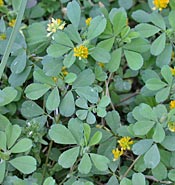 It is a dark green annual with spreading square stems which do not root at the nodes. The only way it reproduces is by seed. Black medic also has three leaflets and is often confused with clover but black medic does not have a white V mark in the center of each leaflet. Bright yellow flowers cluster and as each flower matures it forms a black seedpod containing a single seed. It is a dark green annual with spreading square stems which do not root at the nodes. The only way it reproduces is by seed. Black medic also has three leaflets and is often confused with clover but black medic does not have a white V mark in the center of each leaflet. Bright yellow flowers cluster and as each flower matures it forms a black seedpod containing a single seed.

Buckhorn Plantain (Plantago lanceolata)
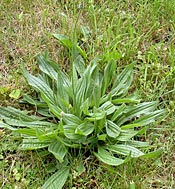 It is a perennial that only reproduces by seed. It has long narrow leaves with prominent parallel veins running the length of the leaf. Buckhorn has a taproot with strong lateral roots. Cutting or pulling the weed will only result in a new plant growing from any part of the root. Seed spikes are fairly small but several crops may be dropped into the soil during a season. It is a perennial that only reproduces by seed. It has long narrow leaves with prominent parallel veins running the length of the leaf. Buckhorn has a taproot with strong lateral roots. Cutting or pulling the weed will only result in a new plant growing from any part of the root. Seed spikes are fairly small but several crops may be dropped into the soil during a season.

Canada Thistle (Cirsium arvense)
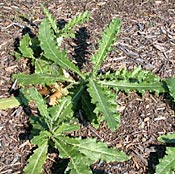 This is a perennial that reproduces by seed and rhizomes. Canada Thistle has an aggressive growth habit and forms dense patches. Leaves are smooth, green on the upper side of the leaf and on the bottom of the leaf it has spiny margins. Flowers are lavender and blooms from June to late fall. This is a perennial that reproduces by seed and rhizomes. Canada Thistle has an aggressive growth habit and forms dense patches. Leaves are smooth, green on the upper side of the leaf and on the bottom of the leaf it has spiny margins. Flowers are lavender and blooms from June to late fall.

Clover (Trifolium repens)
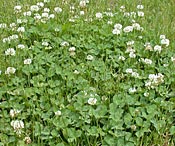 Clover is a perennial with creeping stems that root at the nodes. Clover is recognizable by its dark green color of its three leaflets with a white V mark in the center of each leaflet. The flowers can be white or pinkish in color and usually attracts bees. Clover can be a sign of low fertility. Clover is aggressive and can take over your lawn. Clover is a perennial with creeping stems that root at the nodes. Clover is recognizable by its dark green color of its three leaflets with a white V mark in the center of each leaflet. The flowers can be white or pinkish in color and usually attracts bees. Clover can be a sign of low fertility. Clover is aggressive and can take over your lawn.

Common Mallow (Malva neglecta)
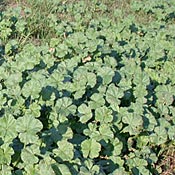 This plant can be perennial or biennial and only reproduces by seed. Mallow emerges from a taproot and sends out stems that trail along the ground but do not root at the nodes, like Ground Ivy. Leaves are kidney shaped and are found on long stems. Flowers are pinkish white and appear from June to late autumn. This plant can be perennial or biennial and only reproduces by seed. Mallow emerges from a taproot and sends out stems that trail along the ground but do not root at the nodes, like Ground Ivy. Leaves are kidney shaped and are found on long stems. Flowers are pinkish white and appear from June to late autumn.

Crabgrass (Digitaria species)
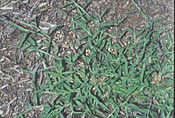 This is an annual that reproduces by seed. It germinates when soil temperatures stay above 59 F. Crabgrass germinates mid to late spring and is usually not visible until July or August. There are two types of crabgrass: Large and Smooth. Both types are yellow green in colour and have wide leaf blades that taper to a point at the end. Crabgrass produces purple seed heads when the plant matures. Flowers from July to September. This is an annual that reproduces by seed. It germinates when soil temperatures stay above 59 F. Crabgrass germinates mid to late spring and is usually not visible until July or August. There are two types of crabgrass: Large and Smooth. Both types are yellow green in colour and have wide leaf blades that taper to a point at the end. Crabgrass produces purple seed heads when the plant matures. Flowers from July to September.

Dandelion (Taraxacum officinale)
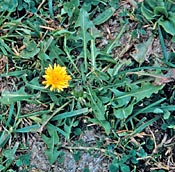 This very hardy perennial has a strong taproot that can go down into the soil from 2 to 3 feet. The only way the dandelion reproduces is by seed. The large yellow blossoms mature into white puffballs full of seeds. These seeds can be carried many miles by the wind. This very hardy perennial has a strong taproot that can go down into the soil from 2 to 3 feet. The only way the dandelion reproduces is by seed. The large yellow blossoms mature into white puffballs full of seeds. These seeds can be carried many miles by the wind.

Ground Ivy (Glechoma hederacea)
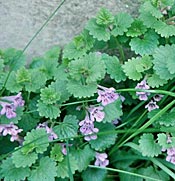 This perennial weed spreads and forms dense patches. The leaves appear opposite each other on square shaped stems and wherever they touch the ground, it takes root. It can also reproduce by seed as well as by the creeping stems. A distinguishing feature of this weed is that when you crush its stem or leaves it has a very strong mint‑like odor. Flowers are purplish blue and are trumpet shaped. This perennial weed spreads and forms dense patches. The leaves appear opposite each other on square shaped stems and wherever they touch the ground, it takes root. It can also reproduce by seed as well as by the creeping stems. A distinguishing feature of this weed is that when you crush its stem or leaves it has a very strong mint‑like odor. Flowers are purplish blue and are trumpet shaped.

Knotweed (Polygonum aviculare)
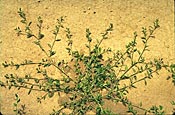 It is an annual plant that reproduces only by seed. Stems form from a thin, tough, wiry, deep penetrating taproot. Tiny white flowers are not noticeable and are found between the leaf and stem. Knotweed prefers compacted soil usually along driveways, high traffic areas, football fields, etc. It is an annual plant that reproduces only by seed. Stems form from a thin, tough, wiry, deep penetrating taproot. Tiny white flowers are not noticeable and are found between the leaf and stem. Knotweed prefers compacted soil usually along driveways, high traffic areas, football fields, etc.

Oxalis (Oxalis stricta)
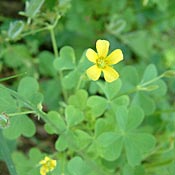 Oxalis is an upright perennial that only reproduces by seed. It has 3 pale green leaflets that are heart shaped and similar to clover. Flowers are small and have 5 yellow petals. As the flowers mature a cucumber shaped seedpod forms. When the seedpod is completely dry, the slightest touch will cause the seeds to be scattered over several feet. Oxalis is an upright perennial that only reproduces by seed. It has 3 pale green leaflets that are heart shaped and similar to clover. Flowers are small and have 5 yellow petals. As the flowers mature a cucumber shaped seedpod forms. When the seedpod is completely dry, the slightest touch will cause the seeds to be scattered over several feet.

Plantain (Plantago major)
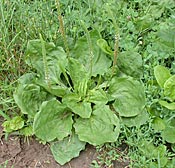 This is a perennial plant that only reproduces by seed. Leaves are large, rounded, dull green and are from 3” to 6” in length. Seeds are compressed along more than half the length of 5” to 10” stalks. There are two types of plantain: 1) Rugel’s Plantain which has a purplish color to the stems and the leaves are green, 2) Common Plantain has a short pale green stem and the leaves are covered with short, rough hairs. This is a perennial plant that only reproduces by seed. Leaves are large, rounded, dull green and are from 3” to 6” in length. Seeds are compressed along more than half the length of 5” to 10” stalks. There are two types of plantain: 1) Rugel’s Plantain which has a purplish color to the stems and the leaves are green, 2) Common Plantain has a short pale green stem and the leaves are covered with short, rough hairs.

Purslane (Portulaca oleracea)
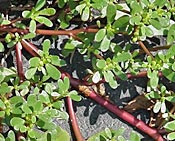 It is an annual and only reproduces by seed. The sprawling stems are thick, round, fleshy and are reddish brown in color. Leaves are bright green, wedge shaped, rubbery and thick. Purslane has tiny yellow flower with 5 petals and they seldom open unless the sun is shining. The cup shaped seedpods produce many small black seeds and these seeds may lie dormant in the soil for many years. It thrives in extremely hot, dry weather. It is an annual and only reproduces by seed. The sprawling stems are thick, round, fleshy and are reddish brown in color. Leaves are bright green, wedge shaped, rubbery and thick. Purslane has tiny yellow flower with 5 petals and they seldom open unless the sun is shining. The cup shaped seedpods produce many small black seeds and these seeds may lie dormant in the soil for many years. It thrives in extremely hot, dry weather.

Quackgrass (Agropyron repens)
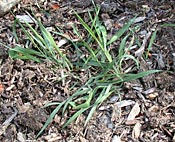 This is a perennial that reproduces by seed and rhizomes. The leaf blade is broader, grows faster, taller and is a lighter green in colour than the rest of your lawn. Quackgrass can spread quickly giving your lawn an uneven appearance. It produces seed heads from June to September. This is a perennial that reproduces by seed and rhizomes. The leaf blade is broader, grows faster, taller and is a lighter green in colour than the rest of your lawn. Quackgrass can spread quickly giving your lawn an uneven appearance. It produces seed heads from June to September.

Speedwell (Veronica species)
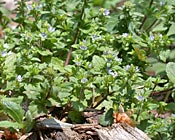 There are many types of Speedwell that can grow in your lawn. Some are annual that reproduce from seed and others are perennial that can reproduce by seed, rhizomes or creeping stems. The perennial plants are generally more difficult to control. There are many types of Speedwell that can grow in your lawn. Some are annual that reproduce from seed and others are perennial that can reproduce by seed, rhizomes or creeping stems. The perennial plants are generally more difficult to control.

Spotted Spurge (Euphorbia supine)
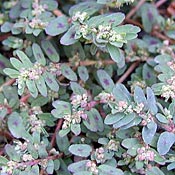 It is an annual and only reproduces by seed. Leaves vary in color from a reddish green to a dark green but usually have a purplish brown “splotch” near the middle of the leaf. Flowers are tiny, pinkish white and are hard to see. One way to identify spotted spurge is by breaking the stems or branches and a milk like liquid comes out. It is an annual and only reproduces by seed. Leaves vary in color from a reddish green to a dark green but usually have a purplish brown “splotch” near the middle of the leaf. Flowers are tiny, pinkish white and are hard to see. One way to identify spotted spurge is by breaking the stems or branches and a milk like liquid comes out.

Violets (Viola species)
 There are two types of violets commonly found on lawns. They include field violets which is an annual weed and sweet violets which is a perennial weed. The violets reproduce by either seed or rootstalks. Their heart shaped leaves and their white, yellow or purple flowers distinguish them. Both types of violets are difficult to control. There are two types of violets commonly found on lawns. They include field violets which is an annual weed and sweet violets which is a perennial weed. The violets reproduce by either seed or rootstalks. Their heart shaped leaves and their white, yellow or purple flowers distinguish them. Both types of violets are difficult to control.
 |

